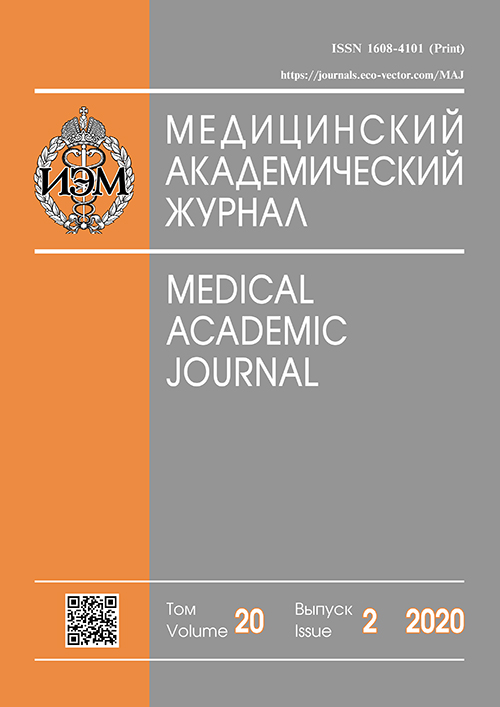Clinical and neurophysiological peculiarities of tumor-related epilepsy
- Authors: Tolstykh N.V.1, Gurchin A.F.1, Koroleva N.Y.1, Stolyarov I.D.1
-
Affiliations:
- N.P. Beсhtereva Institute of the Human Brain of the Russian Academy of Sciences
- Issue: Vol 20, No 2 (2020)
- Pages: 87-96
- Section: Clinical research
- Published: 02.09.2020
- URL: https://journals.eco-vector.com/MAJ/article/view/33822
- DOI: https://doi.org/10.17816/MAJ33822
- ID: 33822
Cite item
Abstract
Detection and correction of structural tumor-associated epilepsy remain relevant at the present time. Seizures occur in 75–90% of cases in patients with gliomas of malignancy’s various degrees.
The aim of this work was to clarify the links of pathogenesis and clinical and neurophysiological features of structural epilepsy in intracerebral tumors.
Materials and methods. We examined 23 patients with intracerebral tumors and symptomatic epilepsy.
Results. Epileptiform activity was registered in 2 or more regions in more than half of the patients — 12 people (52.18%), and 7 of them (58.3%) it spread to neighboring leads. No association was found between the size of the tumor and the number of attacks.
Conclusions. Grade I–II tumors predominate among patients with tumor-related epilepsy. In this population with a high frequency after surgery, both tumor control and freedom from seizures can be achieved. It is necessary to manage this group of patients after surgery with regular neurophysiological monitoring (MRI, positron-emission tomography and video-EEG monitoring) to correct antiepileptic therapy and maintain a high level of quality of life.
Keywords
Full Text
About the authors
Nadezhda V. Tolstykh
N.P. Beсhtereva Institute of the Human Brain of the Russian Academy of Sciences
Author for correspondence.
Email: zaratustra-e@yandex.ru
ORCID iD: 0000-0003-4403-8783
neurologist, office neurology of Outpatient Advisory Department
Russian Federation, Saint PetersburgAlexander F. Gurchin
N.P. Beсhtereva Institute of the Human Brain of the Russian Academy of Sciences
Email: agurchin@gmail.com
candidate of medical Sciences, neurosurgeon, senior researcher of the Laboratory of Neuroimaging
Russian Federation, Saint PetersburgNadezhda Yu. Koroleva
N.P. Beсhtereva Institute of the Human Brain of the Russian Academy of Sciences
Email: koroleva.ny@gmail.com
the Head of the office of neurology of Outpatient Advisory Department, junior researcher of the Laboratory of Stereotactic Methods
Russian Federation, Saint PetersburgIgor D. Stolyarov
N.P. Beсhtereva Institute of the Human Brain of the Russian Academy of Sciences
Email: sid@ihb.spb.ru
ORCID iD: 0000-0001-8154-9107
MD, PhD, DSci (Medicine), Professor, the Head of the Laboratory of Neuroimmunology
Russian Federation, Saint PetersburgReferences
- Hauser WF. The descriptive epidemiology of epilepsy. Epilepsy: translational, clinical and social aspects. Moscow; 2013.
- Scheffer IE, Berkovic S, Capovilla G, et al. ILAE classification of the epilepsies: Position paper of the ILAE Commission for Classification and Terminology. Epilepsia. 2017;58(4):512-521. https://doi.org/10.1111/epi.13709.
- Cascino GD. Epilepsy and brain tumors: implications for treatment. Epilepsia. 1990;31 Suppl. 3:S37-44. https://doi.org/10.1111/j.1528-1157.1990.tb05858.x.
- Толстых Н.В., Гурчин А.Ф., Королева Н.Ю., и др. Современные представления о патогенезе опухоль-ассоциированной эпилепсии // Медицинский академический журнал. – 2019. – Т. 19. – № 2. – С. 13–25. [Tolstykh NV, Gurchin AF, Koroleva NY, et al. Modern conceptions about the pathogenesis of tumor-related epilepsy. Med Akad Z. 2019;19(2):13-25. (In Russ.)]. https:doi.org/10.17816/ MAJ19213-25.
- Zanello M, Pages M, Roux A, et al. Epileptic seizures in anaplastic gangliogliomas. Br J Neurosurg. 2017;31(2):227-233. https://doi.org/10.1080/02688697.2016.1220506.
- Rahman Z, Wong CH, Dexter M, et al. Epilepsy in patients with primary brain tumors: The impact on mood, cognition, and HRQOL. Epilepsy Behav. 2015;48:88-95. https://doi.org/10.1016/j.yebeh.2015.03.016.
- Maschio M, Sperati F, Dinapoli L, et al. Weight of epilepsy in brain tumor patients. J Neurooncol. 2014;118(2):385-393. https://doi.org/10.1007/s11060-014-1449-7.
- Dobran M, Nasi D, Chiriatti S, et al. Prognostic Factors in Glioblastoma: Is There a Role for Epilepsy? Neurol Med Chir (Tokyo). 2018;58(3):110-115. https://doi.org/10.2176/nmc.oa.2017-0167.
- Толстых Н.В., Королева Н.Ю., Столяров И.Д. Особенности течения эпилептического процесса у больных РС // Практическая медицина. – 2019. – Т. 17. – № 7. – С. 67–73. [Tolstykh NV, Koroleva NY, Stolyarov ID. Peculiarities of epileptic process in MS patients. Practical Medicine. 2019;17(7):67-73. (In Russ.)]. https://doi.org/10.32000/2072-1757-2019-7-67-73.
- Elf K, Ronne-Engstrom E, Semnic R, et al. Continuous EEG monitoring after brain tumor surgery. Acta Neurochir (Wien). 2019;161(9):1835-1843. https://doi.org/10.1007/s00701-019-03982-6.
- Arik Y, Leijten FS, Seute T, et al. Prognosis and therapy of tumor-related versus non-tumor-related status epilepticus: a systematic review and meta-analysis. BMC Neurol. 2014;14:152. https://doi.org/10.1186/1471-2377-14-152.
- Карлов В.А. Судорожный эпилептический статус. – М.: Медпресс-информ, 2003. – 166 c. [Karlov VA. Sudorozhnyy epilepticheskiy status. Moscow: Medpress-inform; 2003. 166 p. (In Russ.)]
- Brophy GM, Bell R, Claassen J, et al. Guidelines for the evaluation and management of status epilepticus. Neurocrit Care. 2012;17(1):3-23. https://doi.org/10.1007/s12028-012-9695-z.
- Marcuse LV, Lancman G, Demopoulos A, Fields M. Nonconvulsive status epilepticus in patients with brain tumors. Seizure. 2014;23(7):542-547. https://doi.org/10.1016/j.seizure.2014.04.003.
- Goonawardena J, Marshman LA, Drummond KJ. Brain tumour-associated status epilepticus. J Clin Neurosci. 2015;22(1):29-34. https://doi.org/10.1016/j.jocn.2014.03.038.
- Maschio M, Beghi E, Casazza MML, et al. Patterns of care of brain tumor-related epilepsy. A cohort study done in Italian Epilepsy Center. PLoS One. 2017;12(7):e0180470. https://doi.org/10.1371/journal.pone.0180470.
- Mittal S, Barkmeier D, Hua J, et al. Intracranial EEG analysis in tumor-related epilepsy: Evidence of distant epileptic abnormalities. Clin Neurophysiol. 2016;127(1):238-244. https://doi.org/10.1016/j.clinph.2015.06.028.
- Gallagher P, Leach JP, Grant R. Time to focus on brain tumor-related epilepsy trials. Neurooncol Pract. 2014;1(3):123-133. https://doi.org/10.1093/nop/npu010.
- de Groot J, Sontheimer H. Glutamate and the biology of gliomas. Glia. 2011;59(8):1181-1189. https://doi.org/10.1002/glia.21113.
- Goldstein ED, Feyissa AM. Brain tumor related-epilepsy. Neurol Neurochir Pol. 2018;52(4):436-447. https://doi.org/10.1016/j.pjnns.2018.06.001.
Supplementary files















